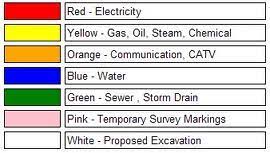The American Public Works Association (APWA) was founded in 1937. Many years later, probably in the 1960’s, the APWA originated a color code for the utility industry.
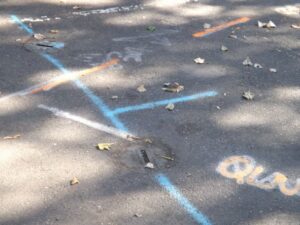
Blue is the APWA color for culinary/potable water.
They have encouraged all utility operators, utility locators, excavators, utility surveyors, and civil engineers to abide by this code. The code was meant to be used in a variety of ways to help identify the utilities: red for electric, blue for water, etc. That identification can be seen in the modern yellow poly pipes for gas and the orange bands commonly attached to fiber optic cable. When an excavator uncovers red warning tape, it means there is a power line buried below.
However, although the code is used in various ways throughout the utility industry, it is most commonly noticed by the public from the One Call paint marks on the streets and sidewalks before excavation.
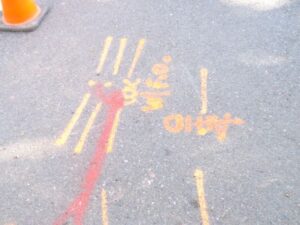
Orange represents any type of communication cable, which includes fiber optic, coaxial and telephone.
In any given area, orange is usually the most common color being used because it represents communication cables. This includes fiber optic cable, coaxial cable, and telephone. With fiber cable alone this can represent cables owned by the local telco, the cable TV company (who use both coaxial and fiber), a long haul fiber company, or even a municipally owned fiber operation. Almost every state in the U.S. now has a statewide ATMS traffic system which is connected with fiber cable, and many power companies are now using fiber for internal communication. The result is that once all of the utilities are marked there is some blue, some yellow, a fair amount of red, and a whole lot of orange.
In the United States this color code is very prevalent, but not completely universal. It is still possible to find small areas of the country which appear to be using their own color code. However, knowing the APWA color code is essential for anyone working in or around the utility industry.
Other nations have also adopted the APWA code. It is the standard utility color code in the United Kingdom as well as other countries.
Not all paint on the ground indicates the presence of buried utilities. The APWA code recommends pink paint for survey. This may be strictly for survey set-up points, but it is also used by many SUE firms to mark utilities for being surveyed to distinguish the SUE marks from One Call marks.
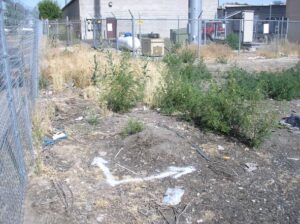
White paint marks indicate the boundaries of proposed excavation.
White paint indicates proposed excavation. This is usually done with a white outline around the intended area of excavation, and possibly just at the corners of a large area.
There is also a procedure known as “positive response” where paint marks indicate no buried utilities. If the excavator calls in an area to be marked, but the utility locators check the area and find that there is nothing buried in the area, they could just leave the site, but that would leave the excavator wondering why the utility was not marked.
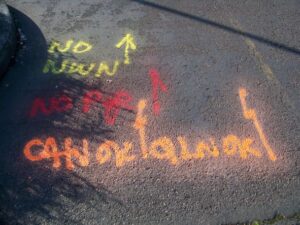
Positive Response is the procedure of marking a dig site as clear.
The solution is to mark the area as clear. As an example: if the utility owner is Unified Gas Company, and the utility locator concludes that the area is clear, then they would probably mark “UGC – OK” in yellow paint. Any other locators that also find that they do not have any facilities within the dig site will also mark an acronym and OK. Locate technicians usually try to group their markings so they are more visible.


